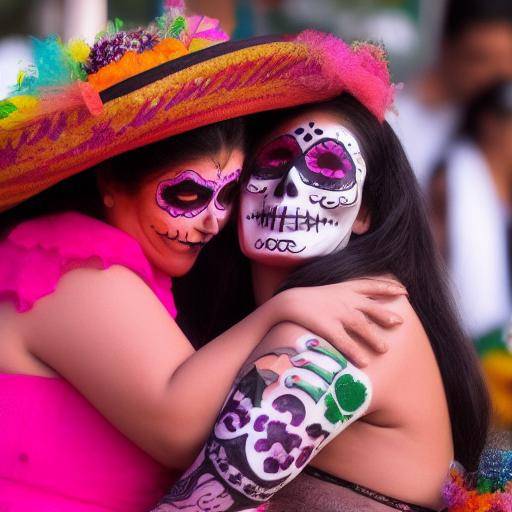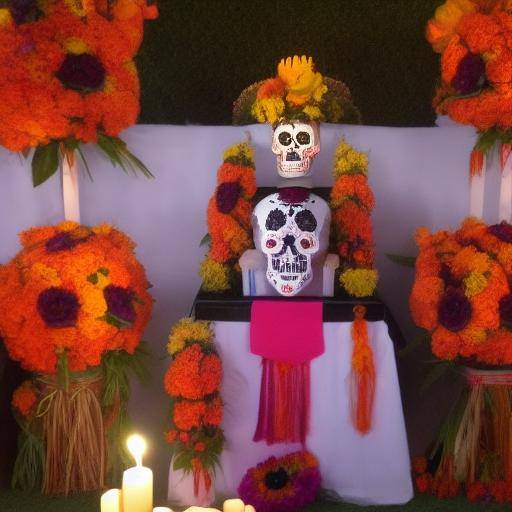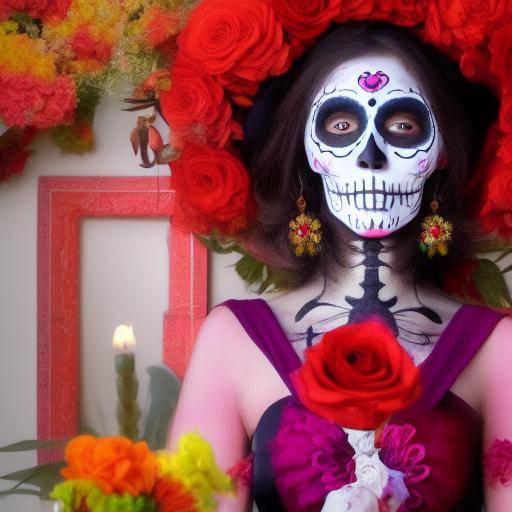
The Day of Dead is one of the most emblematic celebrations in Mexico. This colorful and touching holiday honors loved ones who have passed away, celebrating the connection between the living and the dead. During this celebration, families gather to remember, celebrate and pay tribute to their ancestors, creating a bridge between the earthly and spiritual world. In this article, we will explore in depth the meaning and traditions of the Day of Dead, as well as the offerings and skulls that are vital to this feast.
Introduction
The Day of the Dead, also known as All Saints and Day of the Faithful, is a traditional Mexican celebration that has its roots in the fusion of Mesoamerican indigenous traditions and Catholic holidays. This captivating holiday takes place annually from 31 October to 2 November, coinciding with the Catholic celebration of the Day of All Saints. During these days, Mexico becomes a place where color, music and aromas combine to create a unique experience that honors those who have left.
History and Background
The Day of Dead has a rich and diverse history that goes back to ancient Mesoamerican civilizations. Before the arrival of the Spanish conquerors, indigenous peoples such as Aztecs, Mayas, Purépechas, and others paid tribute to their deceased with rituals that honored life and death as an integral part of human existence. The arrival of Catholicism during the Spanish conquest brought with it the fusion of these pre-Hispanic traditions with Catholic festivities, creating the synchrotic festivities that we know today as the Day of the Dead.
During the pre-Hispanic period, the festival was celebrated in the ninth month of the Mexican solar calendar, approximately at the beginning of August, and was dedicated to Mictecacíhuatl, the goddess of the deceased, and to the children and adults who died. After the arrival of the Spaniards, the festival moved to the Catholic calendar to coincide with the Christian festivities of All Saints and the Faithful.
Over the centuries, the Day of the Dead has evolved and acquired new traditions, but its essence of love, respect and connection with loved ones who have passed away has remained inconclusive. The celebration has been recognized by UNESCO as the Intangible Cultural Heritage of Humanity.
Offerings: The Link between the Living and the Dead
One of the most significant traditions of the Day of Dead is the creation of offerings, also known as altars. These beautiful and elaborate displays are mounted in homes, pantheons, schools, offices and public spaces, and serve to receive and honor the spirits of loved ones who return to visit their families. The offerings are loaded with symbolism and meaning, incorporating elements such as photographs of the deceased, candles, flowers, food, drink, personal objects and other elements that were appreciated by those who are paid tribute.
The construction of an offering is a meticulous process that reflects the creativity, devotion and affection of those who make it. Through the offerings, the living demonstrate that the memory of the dead remains alive in their hearts, and are willing to share with them the best of what they enjoyed in life. The offerings also offer a space for dialogue between the living and the dead, creating a connection that transcends the earthly world.
Skulls: The Art and Celebration of Life and Death
Another iconic representation of the Day of the Dead are the skulls, which can take various forms, includingamazing sugar skulls and intricately decorated sugar skulls (sugar skulls). These colorful and detailed skulls are symbols of joy and celebration of life and death. Often, they are used as decorations for the altars and as gifts to honor the deceased. They are also artistic representations that seek to celebrate and demystify the figure of death, reminding us that it is a natural part of the cycle of life.
The skulls, whether of sugar, mache paper or other materials, are an artistic manifestation that combines aesthetics with spirituality. Through their elaborate ornamentation and vibrant colors, they convey the idea that death should not be feared, but must be remembered and celebrated. The skulls, like the offerings, are a reflection of Mexican creativity and ingenuity, and have won international recognition as distinctive symbols of the feast of the Day of Dead.
Conclusion
The Day of the Dead, with its offerings and skulls, is a celebration that transcends mourning and sadness, transforming death into a celebration of life and an opportunity to honor our ancestors. Through these traditions rooted in Mexican history and culture, a connection between past and present generations is achieved, reminding those who are no longer physically present, but whose legacy and memories persist in the memory and spirit of those who loved them.
This unique holiday, full of color, meaning and tradition, teaches us that death is not the end, but part of a continuous cycle of life. The Day of Dead invites us to embrace death with respect, joy and love, showing that, even in physical absence, our loved ones never completely abandon us.
Let us celebrate together the life and memory of our ancestors on this Day of Dead and that their legacy will endure forever!


